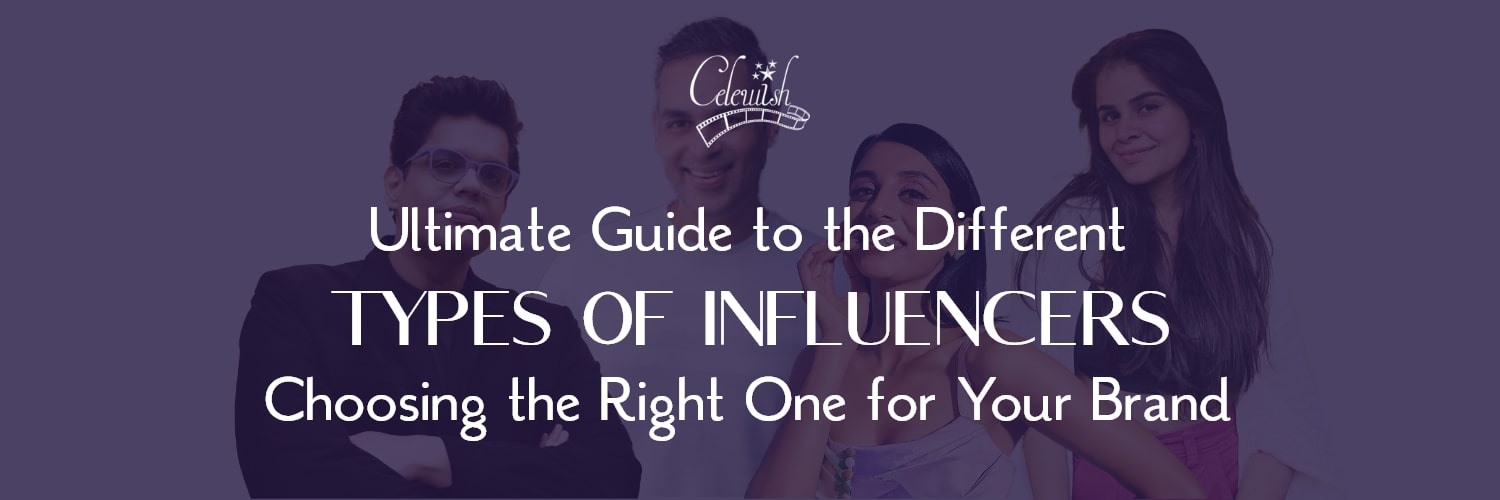
Inspire, Influence, Impact! Finding the right influencer to work with your brand is important to realizing your brand's objectives – or else all your efforts will go to waste too. There are now so many different types of influencers that it's confusing trying to figure out which ones are good fit for your brand. That said, strategically selected influencers can be an incredible choice for any business. They facilitate the establishment of trust with relevant audiences in real time, enhance brand visibility through integrated ways, and drive measurable results—from awareness to conversions. Be it niche micro-influencers or high-visibility content producers, the perfect collaboration can take influence and transform it into actionable business effect. Do you look at their large number of followers, or do you place more importance on their niche or specialty? Do you want celebrities, aspiring faces, or Key Opinion Leaders (KOLs), or do you simply require a smaller cultural footprint individual, but a more attentive audience who will be able to bring more value? This blog will explore types of influencers to determine which one is right for your brand.
Who is an Influencer?
Influencers are people that have huge or active social media audiences who have also outstanding influence in niche fields like beauty, fashion, fitness, travel and food too as well. They are honest and creative in their approaches and they utilize their field expertise and credibility to influence their targeted groups too. Their already existing publicity in a segment provides them the strength to become a good starting point for brands wanting to build a reputation. Indian instagram influencers, among others, are directly influenced by their ability to connect with real fans, build credibility, and impact an audience. For brands, influencer marketers serve as great business partners who actually possess the ability to bridge gaps between products and potential consumers effectively, and thus, they are the pillar of engagement-focused and trust-based promotion schemes in contemporary times. We are a leading influencer marketing agency, helping brands connect with the right influencers to drive authentic engagement and measurable impact across diverse audiences.
Read More: The Ultimate Guide to Choosing the Right Digital Marketing Influencers for Your Endorsement Campaign
Types Of Influencers- The Faces Behind Every Brand
In this part, don't miss out on knowing various types of influencers, typically divided according to how large their audience is and how influential they are:
1. Nano Influencers (1K–10K followers)
Nano influencers have small but extremely engaged audiences. These influencers make content on specialized interests and often share close relationships with fans. Even if it is a lifestyle blogger or travel influencer posting secret gems, the core of grassroots marketing efforts, local audience or specialized businesses willing to reach out to Nano influencers, all focus on genuine engagement and more word-of-mouth influence.
2. Micro-Influencers (10K–100K followers)
Micro-influencers beat a reach vs. engagement balance. These types of influencers are seen as relatable and authoritative, usually concentrating on niche interests or groups. Brands utilize their capacity to create relevant interactions and conversions, providing them with targeting credibility that is within the budget of larger influencers but does not sacrifice their high cost.
3. Macro Influencers (100K–1M followers)
Macro influencers have a large and diverse audience, along with polished, professional content. They tend to be verified social media influencers with wide demographics. Beauty influencers often fall into this category, showcasing high-quality content across diverse audiences. Although activity is slightly off, their engagement is perfect for brands seeking awareness, visibility, and influence from multiple demographics and geographic locations.
4. Mega or Celebrity Influencers (1M+ followers)
If we talk about mega influencers, they are those who have huge followings. They offer immediate exposure and can instantly raise a brand's profile. But their endorsement comes at a high price and is less personal. They are ideal for large brands or new products that need mass appeal and the broadest possible reach among the masses.
5. Key Opinion Leaders (KOLs)
They are established professionals i.e. Key Opinion Leaders in specialized areas like technology, finance or health. The brand is not concerned about follower counts in the case of KOLs, but it wants experience, knowledge and credibility. Fitness influencers India also often fall into this category when they possess deep expertise and a trusted reputation. Brands engage with KOLs to create credibility and authority and to appeal to an educated base that's searching for professional advice before making a choice.
How to Choose the Right Influencer?
Choosing the right influencer is a big task so for this, we’ll explore some important points that brands can easily choose:
1. Audience Alignment
One of the most crucial tasks is to choose influencers whose audience has a strong match to your target audience. On age, place, interests and buying behavior, the more the match, the higher the chance that the campaign will resonate with your audience and convert. Audience match is essential for your messages to reach people most likely to interact and act.
2. Engagement Rates
See beyond the number of followers and concentrate on the degree to which the influencer's followers actively engage with what they post. Most likes, shares and comments indicate a great level of interest and influence. Fashion influencers, like Tanya Chaudhari, for instance, often thrive on this kind of engagement. Good engagement implies that the influencer has earned trust such that their followers will be responsive to your company's message.
3. Authenticity
Select influencers who actively use or believe in your service or product. Genuine endorsements come across more authentically and naturally, and this increases credibility and trust among followers. Most audiences can discern forced promotions, so real passion and real connection with the brand are essential for successful influencer collaborations.
4. Past Campaigns
See the previous work or campaigns of the influencer to judge their performance. Metrics such as engagement, reach and conversion rates can be measured against each other. You can check whether they have a proven history of delivering successful campaigns to other businesses and can demonstrate a record of producing results and also have experience in reformatting content to meet marketing objectives with other audiences and other industries.
Also Read: The Game-Changing Benefits of Influencer Marketing for Your Brand
Fake Influencers: Identifying and Avoiding How?
Fake influencers tend to increase their number of followers and engagement levels to look more influential than they are. To avoid being duped by fake influencers, here are some key pointers:
1. Assess Engagement
Measure an influencer's likes/comments/shares against their number of followers. For actual engagement, you would expect a proportionality of the engagement compared to their audience size. If there are conflicts, this may mean that there are enhanced figures or widget engagement, which can impact the authenticity of any brand enquiry or potential collaboration.
2. Use Tools
Use such tools as Social Blade or HypeAuditor to determine how many real followers an influencer has. Both tools can help you identify fake followers or engagement fraud, giving you a clearer understanding of the influencer's true reach and impact.
3. Look for Red Flags
Watch out for influencers who have a large following but receive minimal engagement on their posts. Low engagement with a lot of followers is usually an indication of bought followers or inactive accounts, and that the influencer may not have actual audience power.
Wrapping Up: Finding the Right Fit Among Influencer Types
Choosing the appropriate influencer for your brand involves thoroughly understanding the types of influencers and their audience, content format, and values so that they suit your marketing needs. A strategic choice will maximize the performance of your influencer campaigns, driving top returns and industry-leading ROI. We can assist you in selecting the perfect influencer at Celewish who will have your target audience engaged and drive your marketing objectives, so your investment will provide real returns. At every path, our team assists you in making the correct choice for long-term brand success.
Frequently Asked Questions (FAQs)
Q1. What type of influencer is best for small businesses?
Micro and nano-influencers are ideal for small businesses. These smaller creators, with between 1,000 and 100,000 people following them, are provided with more engaged audiences and are less expensive to work with than larger influencers. Their specialty groups are very engaged and these influencers provide trust with their opinion, so they are a low-cost way of reaching a specialty audience.
Q2. Can an influencer belong to more than one type?
Yes, an influencer can be a whole category and it's traditional for an influencer to be defined by things such as their 'reach' (mega, macro, micro, nano) 'niche' (beauty, fashion, travel, tech) and 'role' (brand ambassador, content creator). There is over one category for influencers such as a micro influencer within the fashion category can also be a content creator.
Q3. What type of influencers are the most popular?
Of the influencer types, mega influencers and macro influencers stand out in that they have larger audiences and greater reach. These influencers, beyond celebrity and personality, provide massive reach and are suitable for companies that want the utmost exposure. Nowadays, these influencers are also becoming very popular since they can provide better visibility and reach more specialized consumers more effectively too as well.
Q4. Which platform is also best for influencer marketing?
If we talk about which platform is best fit for influencer marketing, then Instagram and YouTube are because these platforms have a large audience and extensive interaction. Twitter, LinkedIn and Snapchat are not the trend channels, and neither are they trend channels for B2C brands. Others could be popular too, such as an Influencer.in Chatbox, Plix and so on, and also fast-growing apps such as Heapsy, Viral Nation and more.
Q5. How do you categorize an influencer?
There are usually influencer types by follower size and influence. Nano influencers have fewer than 1 thousand followers, micro influencers have 10 thousand to 100K, macro influencers have 100K to 1M and mega influencers have more than 1M too. Aside from that, they are also categorized as Key Opinion Leaders (KOLs) according to what industry experience they possess and not by follower count, and they provide credibility and authority too.

